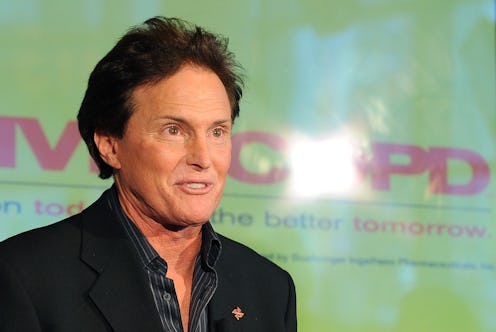Entertainment
"Bruce Jenner" Wikipedia Page Uses Female Pronouns
There are so many valuable points to be taken from Caitlyn Jenner's Vanity Fair cover and transition in general: How tragic it is for people to live in fear and shame, unable to be their truest selves; How lucky some of us are to be born in the body we belong in; How unbelievably content and confident the person we used to call "Bruce" looks as Caitlyn. But also, because she has been generous and brave enough to share her story with us, Caitlyn's transition also offers an opportunity for mainstream, cisgendered America to learn about the transgender community.
Being so high profile, Caitlyn's transition is something we should all take stock and learn from, because even for the most privileged (read: wealthy, educated, white, like Jenner) people in our society, coming out as transgender can be a painful, terrifying, but awesomely beautiful and fulfilling process that the rest of us should throw our support behind wholeheartedly. Because as difficult as it's been for Caitlyn, imagine that difficulty multiplied for every non-famous, non-rich, and/or non-white gender misaligned person living in an intolerant world. We can start learning about the proper use of gender pronouns, with Caitlyn Jenner's Wikipedia page as a perfect example of the correct before and after language we should be employing.
Caitlyn herself, in conversation with Vanity Fair's Buzz Bissinger, admits that even for her, allowing her new identity to become habitual is a slow process (as told in her signature good humored, kind-hearted manner):
"Bissinger apologizes to Jenner for repeated pronoun confusion and asks whether she is sensitive about it. “I don’t really get hung up,” she tells him. “A guy came in the other day and I was fully dressed—it’s just habit, I said, ‘Hi, Bruce here,’ and I went, Oh fuck, it ain’t Bruce, I was screwing up doing it.”"
Which brings up an important point when it comes to our relationships with transgender loved ones in our own lives: Getting things "right" in terms of using all the correct language, and generally allowing them to transition in your mind, might be a slow process for us too, whether it's remembering to use the right pronouns for Caitlyn or someone closer to us. Nonetheless, it's an incredibly necessary process, and one that we should all consciously be trying to expedite. So while you're not the worst person in the world for calling Caitlyn Jenner "Bruce" or "he" a few times (spoiler: it's happened at the Bustle office today, and will probably happen again), now that she is living and identifying publicly, full-time, as a woman, we need to be actively adopting feminine pronouns when referring to Caitlyn.
This shift can be seen illustrated on Caitlyn Jenner' Wikipedia page (previously existing under "Bruce Jenner"). While the page's URL still reflects the name "Bruce" (hey, Rome wasn't built in a day, guys), the page lists her as "Caitlyn Jenner" and uses female pronouns throughout. These changes were made within hours of Vanity Fair releasing the Annie Leibovitz-shot cover featuring Jenner.
Here are some screen shots of Caitlyn's Wikipedia before her transition:
The Wikipedia has been change to reflect the changes to Caitlyn's name and physicality, and the new opening paragraph reads (emphasis added):
"Caitlyn Jenner (born William Bruce Jenner, October 28, 1949), formerly known as Bruce Jenner, is an American former track and field athlete and current television personality.
Jenner came to international attention when, while still identifying as a man, she won the gold medal in the decathlon at the 1976 Summer Olympics held in Montreal. Subsequently she starred in several made-for-TV movies and was briefly Erik Estrada's replacement on the TV series CHiPs.
Jenner was married for nearly 24 years to Kris Jenner (formerly Kardashian); the couple and their children appeared beginning in 2007 on the television reality series Keeping Up with the Kardashians. Following her divorce in 2015, Jenner came out in a television interview as a trans woman, initially preferring male pronouns until her transition was more complete. On June 1, 2015, Jenner revealed her new name, Caitlyn, and her use of female pronouns officially. Many news sources have described Jenner as the most famous openly transgender American."
Just because Caitlyn Jenner's physical manifestation as a woman is only very recent, it doesn't mean that Caitlyn hasn't ALWAYS been a woman. It is our responsibility as good, kind, helpful, empathetic, tolerant and participating members of our society to acknowledge Caitlyn as a full human, and allow her to still possess her past while embracing her future. From today forward, we refer to Caitlyn, whether in the present, future or past tense, as SHE and HER. We don't have to un-know Bruce as a person, we do need to unlearn the gender pronouns we previously used and make a point to not dead name "Bruce" when we really mean Caitlyn (I'm doing it here to be able to make a clear point, but Caitlyn is Caitlyn, now and also in the past). Think of it this way: everything Caitlyn lived as Bruce she lived as Caitlyn too—we just couldn't see her there, but now we can.
Images: Wikipedia (4)
